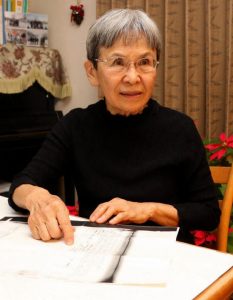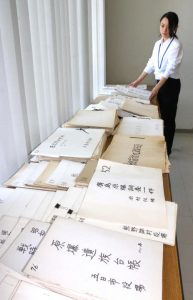In August, 2023, Hiroshima City government releases information of five people from lists of A-bomb victims; clues to knowing about their last moments
Dec. 25, 2023
Bereaved family member in Tokyo receives news about her uncle 78 years after atomic bombing
by Kana Kobayashi, Staff Writer
This is the 55th year since the Hiroshima City government began to make public the lists of A-bomb victims, which serve as clues to learning about those missing after the atomic bombing. The city government publicly exhibits the lists prior to August 6 every year, the anniversary of the atomic bombing on Hiroshima. In response to telephone inquiries and in-person inquiries in 2023, the city government confirmed and released information about the cause and dates of death of five A-bomb victims on those lists. The lists of A-bomb victims have served as support to A-bomb victims’ bereaved families trying to fill a “void” in information that still remains 78 years after the atomic bombing.
The lists of A-bomb victims were made public for the first time in July of 1968, prompted by the immediately prior discovery of post-mortem reports for about 10,000 A-bomb victims at the Hiroshima East Police Station. According to an article in the Chugoku Shimbun at the time, a total of 14 documents were made public, including a list of names of those who died in an army hospital, and about 300 people flooded into the venue that first day.
Since then, information has been added to the original lists whenever a list of patients hospitalized in a hospital or a list of the dead compiled by a local public office was newly found. At present, a total of 82 lists of A-bomb victims contain roughly 23,000 names. Many of these lists began to be compiled in the confusion immediately after the atomic bombing. The lists are made public from August 1 to 6 every year at the Hiroshima International Conference Center Hiroshima, located in the city’s Naka Ward. Only relatives of A-bomb victims are allowed to submit an application to the reception desk. If the name written in the application is found on the lists, the city government will provide a copy of the corresponding information. An application can be submitted by phone as well.
Michie Haoka, 76, a resident of Kokubunji City in Tokyo, learned about the lists being made public from the TV news. She inquired about Nobuyoshi Origuchi this year, a younger brother of her mother Yuriko Bukeo (who died at the age of 59 in 1987), by phone. Mr. Origuchi was a first-year student at the former Sotoku Junior High School at the time of the atomic bombing. Ms. Haoka learned that a post-mortem report possessed by the East Police Station stated Mr. Origuchi was burned to death in the Hatchobori area (now part of the city’s Naka Ward) at 9 a.m. on August 6, 1945, and cremated.
Mr. Orikuchi is thought to have been at a site where he was mobilized for the war effort. His remains have not been found. While her mother was alive, and Ms. Haoka would ask about him, her mother always responded with such words as “I don’t want to talk about him, I can’t. It’s too painful.” When Ms. Haoka received a copy of the post-mortem report of her uncle from the Hiroshima City government, she put her hands together in front of a photograph of her mother and told her, “The record of uncle Nobuyoshi was found.”
Each of the 82 lists captures different details. The post-mortem reports possessed by the East Police Station contain such details as time and location of death, cause of death, facial features, clothes, the name of the doctor witnessing the death, as well as the address, occupation, and age of A-bomb victims. The city’s Peace Promotion Division says a total of 920 people have visited the venue and information about 160 A-bomb victims has been provided to relatives for the past 20 years.
The lists of A-bomb victims, into which the evidence of the lives of A-bomb victims is etched, offer support to bereaved families. In addition to the period between August 1-6, the Hiroshima City government accepts inquiries at other times of the year too. For further information, please contact the city’s Peace Promotion Division at 082-242-7831.
(Originally published on December 25, 2023)









